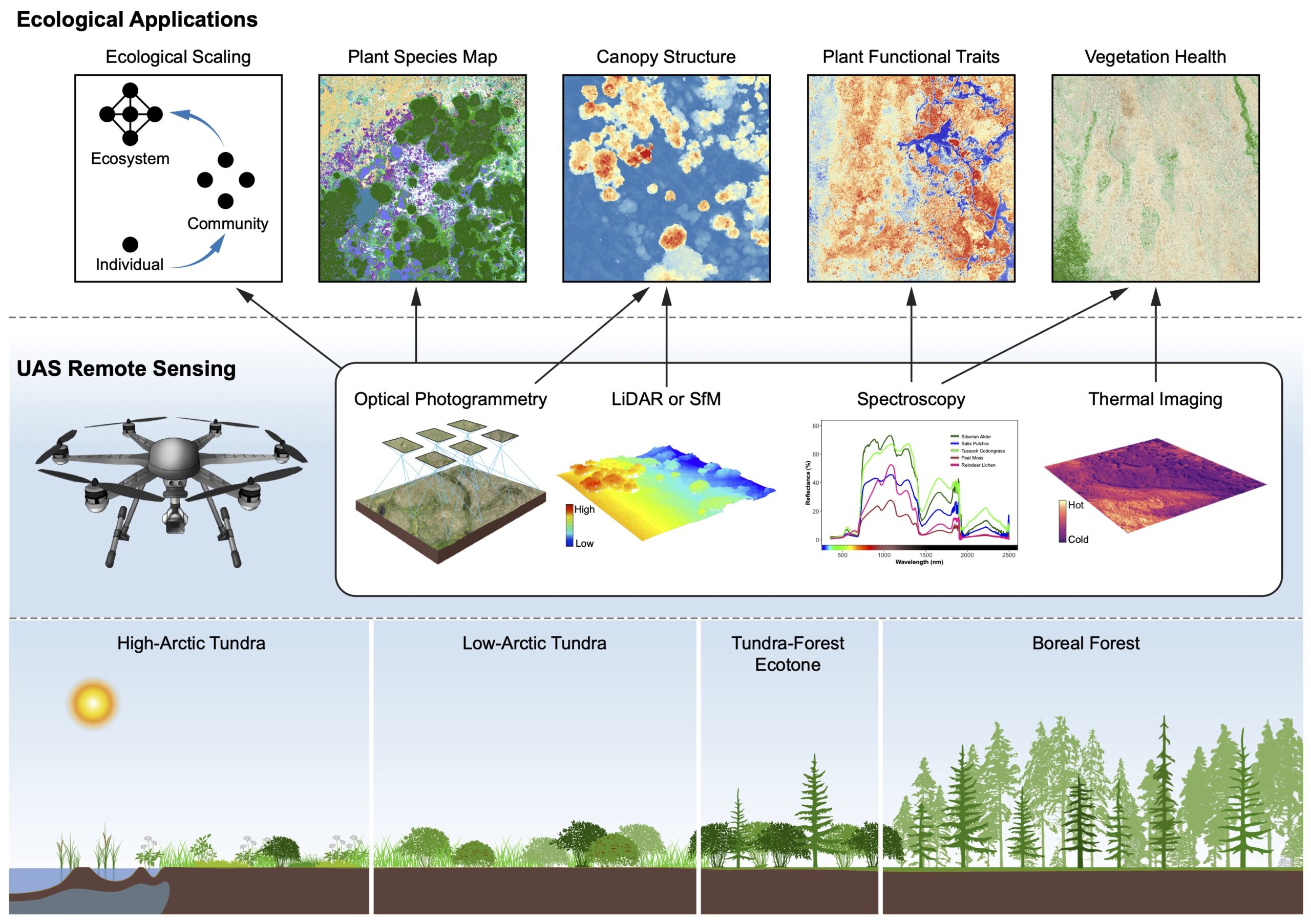July 30, 2022
Drone Remote Sensing Revolutionizes Study of Arctic Plants
Remote sensing from unoccupied aerial systems offers opportunities to enhance Arctic plant ecology in a changing climate.

Illustration of the latitudinal transition of high-latitude biomes (bottom), the Unoccupied Aerial System (UAS) remote sensing technologies (middle), and the key applications of UASs for understanding Arctic ecosystem structure and functioning (top).
[Reprinted with permission from Yang, D., et al. "Remote Sensing from Unoccupied Aerial Systems: Opportunities to Enhance Arctic Plant Ecology in a Changing Climate." Journal of Ecology 110 (12), 2812–35 (2022). DOI:10.1111/1365-2745.13976.]
The Science
The Arctic tundra is a critically understudied biome at the top of the planet that is experiencing the fastest warming on Earth. This warming is impacting the health and distribution of tundra vegetation, which, in turn, impacts biodiversity and the balance of carbon, water, and energy. Tundra landscapes are remote and logistically challenging to study in detail across space and time. These challenges are further complicated by a mismatch between the scale of observation and the scale at which Arctic ecological processes occur, leading to significant uncertainties in understanding and model prediction of the Arctic’s fate.
The Impact
This study reviews how unoccupied aerial system (UAS) remote sensing can be used to enhance Arctic plant research and better understand the impacts from climate change. A team of researchers provided examples of how integration of different remote sensing technologies with UASs could be used to quantify vegetation patterns and processes at scales appropriate for studying Arctic processes (1–10 cm) and enhance the ability to link ground-based measurements with broader-scale information obtained from airborne and satellite platforms. Researchers also provided recommendations on UAS operation in remote regions, data storage and processing, and data sharing protocols to better enable the use of UASs and UAS syntheses to study Arctic ecology.
Summary
The Arctic is warming at a faster rate than any other biome on Earth, resulting in widespread changes in vegetation composition, structure, and function. The heterogeneous nature of Arctic landscapes creates challenges in monitoring and improving understanding of these ecosystems, as most current efforts rely on traditional ground- and satellite-based observations that are limited in either spatial extent or spatiotemporal resolution. The use of remote sensing instrumentation on UASs has emerged as an important tool to view, describe, and quantify vegetation dynamics at scales that are more appropriate for studying Arctic landscapes (1–10 cm). This review discusses how established and emerging UAS remote sensing technologies can enhance Arctic plant ecology by shedding light on fine-scale drivers of vegetation patterns and processes and enhancing the ability to upscale ground-based measurements to airborne and satellite platforms. Researchers reviewed state-of-the-art remote sensing technologies that have been integrated with small UASs and then provided examples of key UAS applications for remote sensing studies in the Arctic. Finally, the review provides perspectives on the remaining challenges associated with collecting data in remote regions along with necessary next steps to advance the future of UAS remote sensing in the Arctic.
Principal Investigator
Shawn Serbin
Brookhaven National Laboratory
sserbin@bnl.gov
Co-Principal Investigator
Dedi (Daryl) Yang
Brookhaven National Laboratory
dediyang@bnl.gov
Program Manager
Daniel Stover
U.S. Department of Energy, Biological and Environmental Research (SC-33)
Environmental System Science
daniel.stover@science.doe.gov
Funding
This work was supported by the Next-Generation Ecosystem Experiments-Arctic (NGEE-Arctic) project that is supported by the Biological and Environmental Research (BER) Program in the U.S. Department of Energy’s (DOE) Office of Science, and through the DOE contract No. DE-SC0012704 to Brookhaven National Laboratory. Support was also received from NASA’s Arctic Boreal Vulnerability Experiment (ABoVE) Grant NNX15AU05A.
Related Links
References
Yang, D., et al. "Remote Sensing from Unoccupied Aerial Systems: Opportunities to Enhance Arctic Plant Ecology in a Changing Climate." Journal of Ecology 110 (12), 2812–35 (2022). https://doi.org/10.1111/1365-2745.13976.

